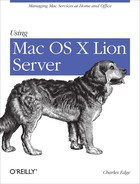The centralized command and control of OS X clients is straightforward, and Apple has made it about as easy as it can be to use. However, centrally managing computers and iOS devices is a complicated task. Doing so should not be undertaken lightly, much as the decision to walk between multiple computers and change settings isn’t undertaken lightly in large environments.
Most existing, large environments will already use Managed Preferences. Doing so is also a straightforward process, as we showed in this chapter. And setting up an Open Directory environment from scratch is fairly straightforward as well, as shown in Chapter 2. The hard part is determining a strategy that works best for you. If you have a small number of devices, just manage the settings on each individually or using a single group. However, if you have a lot of devices (as in 50,000 or more), then you should definitely consider the book Enterprise Mac Managed Preferences by Ed Marczak and Greg Neagle (Apress).
Managing profiles though is an entirely new paradigm. Profiles control managed preferences without a centralized directory service, but go further in layering actual device management on top. This device management gives administrators the ability to lock and even wipe devices from a centralized location. This is the future of centralized command and control of Apple devices, but not quite as mature today as that of Managed Preferences. For smaller environments though, it is probably preferable.
And of course, the Software Update Service gives that final piece of the puzzle, centralizing the ability to deploy patches to Mac OS X computers, including Lion and even Lion Servers. These options can then be deployed with the Managed Preferences or Profiles framework. But our use of Lion Server for the coolest of the cool doesn’t end here.
